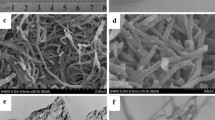Abstract
Polypyrrole (PPy) has attracted wide attention due to its high conductivity, environmental stability, low cost, facile synthesis and doping. However, the rigid backbone and π-conjugation structure of polypyrrole lead to the poor solubility and processability and thus restricting its applications. In this letter, self-suspended PPy was obtained by using a long-chain protonic acid CH3(CH2)8C6H4(OCH2-CH2)10SO3H (NPES) as dopant and then through a common dialysis. Such unique structured PPy is a kind of solvent-free fluid which can flow at or near room temperature. The solubility and processability of self-suspended polypyrrole have been improved effectively due to the introduction of oxyethylene groups and alkyl group. And it also directly presents unique liquid crystal property. Moreover, the self-suspended polypyrrole exhibited a relatively high electrical conductivity reached up to 0.11 S/m, presenting a typical characteristic of the semiconductor. Such self-suspended polypyrrole could be a promising alternative in the field of lightweight battery, super capacitor and metal anti-corrosion.







Similar content being viewed by others
References
Jagur-Grodzinski J (2002) Electronically conductive polymers. Polym Adv Technol 13(9):615–625
Fan LZ, Maier J (2006) High-performance polypyrrole electrode materials for redox supercapacitors. Electrochem Commun 8(6):937–940
Kayrak-Talay D, Akman U, Hortaçsu Ö (2008) Supercritical carbon dioxide immobilization of glucose oxidase on polyurethane/polypyrrole composite. J Supercrit Fluids 44(3):457–465
Gardner JW, Bartlett PN (1993) Design of conducting polymer gas sensors: modelling and experiment. Synth Met 57(1):3665–3670
Somani P, Mandale AB, Radhakrishnan S (2000) Study and development of conducting polymer-based electrochromic display devices. Acta Mater 48(11):2859–2871
Herrasti P, Ocón P (2001) Polypyrrole layers for steel protection. Appl Surf Sci 172(3):276–284
Shen Y, Wan M (2015) Soluble conductive polypyrrole synthesized by in situ doping with β-naphthalene sulphonic acid. J Polym Sci A Polym Chem 35(17):3689–3695
Masuda H, Asano DK (2003) Preparation and properties of polypyrrole. Synth Met 135(135):43–44
Brie M, Turcu R, Mihut A (1997) Stability study of conducting polypyrrole films and polyvinylchloride-polypyrrole composites doped with different counterions. Mater Chem Phys 49(2):174–178
Satoh M, Kaneto K, Yoshino K (1986) Dependences of electrical and mechanical properties of conducting polypyrrole films on conditions of electrochemical polymerization in an aqueous medium. Synth Met 14(4):289–296
Kim DY, Lee JY, Kim CY, Kang ET, Tan KL (1995) Difference in doping behavior between polypyrrole films and powders. Synth Met 72(3):243–248
Jang KS, Lee H, Moon B (2004) Synthesis and characterization of water soluble polypyrrole doped with functional dopants. Synth Met 143(3):289–294
Bourlinos A, Ray Chowdhury S, Herrera R, Jiang D, Zhang Q, Archer L et al (2005) Functionalized nanostructures with liquid-like behavior: expanding the gallery of available nanostructures. Adv Funct Mater 15(8):1285–1290
Moganty SS, Jayaprakash N, Nugent JL, Shen J, Archer LA (2010) Ionic-liquid-tethered nanoparticles: hybrid electrolytes. Angew Chem 49(48):9158–9161
Liu DP, Li GD, Su Y, Chen JS (2006) Highly luminescent zno nanocrystals stabilized by ionic-liquid components. Angew Chem 45(44):7370–7373
Kim D, Kim Y, Cho J (2013) Solvent-free nanocomposite colloidal fluids with highly integrated and tailored functionalities: rheological, ionic conduction, and magneto-optical properties. Chem Mater 25(19):3834–3843
Smarsly B, Kaper H (2005) Liquid inorganic-organic nanocomposites: novel electrolytes and ferrofluids. Angew Chem Int Ed Eng 44(25):3809–3811
Rodriguez R, Herrera R, Archer LA, Giannelis EP (2008) Nanoscale ionic materials. Adv Mater 20(22):4353–4358
Bourlinos AB, Herrera R, Chalkias N, Jiang DD, Zhang Q, Archer LA et al (2005) Surface functionalized nanoparticles with liquid-like behavior. Adv Mater 17(2):234–237
Feng Q, Dong L, Huang J, Li Q, Fan Y, Xiong J et al (2010) Fluxible monodisperse quantum dots with efficient luminescence. Angew Chem 49(51):9943–9946
Tang Z, Cheng G, Chen Y, Yu X, Wang H (2014) Characteristics evaluation of calcium carbonate particles modified by surface functionalization. Adv Powder Technol 25(5):1618–1623
Li Q, Dong L, Liu Y, Xie H, Xiong C (2011) A carbon black derivative with liquid behavior. Carbon 49(3):1047–1051
Huang J, Wang M, Wang S, Wang T, Li Q, Dong L et al (2016) Self-suspended polyaniline containing self-dissolved lyotropic liquid crystal with electrical conductivity. J Polym Sci A Polym Chem 54(22):3578–3582
Huang J, Liu Z, Wang S, Yang Q, Liu B, Liu L et al (2016) Preparation and characterization of self-suspended tetraaniline with liquid crystal texture. Synth Met 220:428–432
Yurtsever E, Esentürk O, Pamuk HÖ, Yurtsever M (1999) Structural studies of polypyrroles: ii. A monte carlo growth approach to the branch formation. Synth Met 98(3):229–236
Acknowledgements
We are grateful to the financial support of National Natural Science Foundation of China (No. 51673154).
Author information
Authors and Affiliations
Corresponding authors
Rights and permissions
About this article
Cite this article
He, J., Xie, H., Hong, J. et al. Self-suspended polypyrrole with liquid crystal property. J Polym Res 25, 56 (2018). https://doi.org/10.1007/s10965-018-1462-1
Received:
Accepted:
Published:
DOI: https://doi.org/10.1007/s10965-018-1462-1




